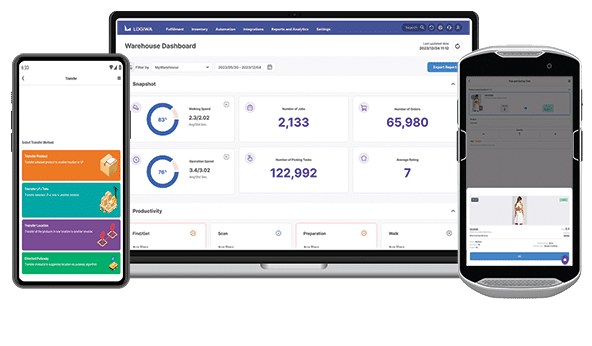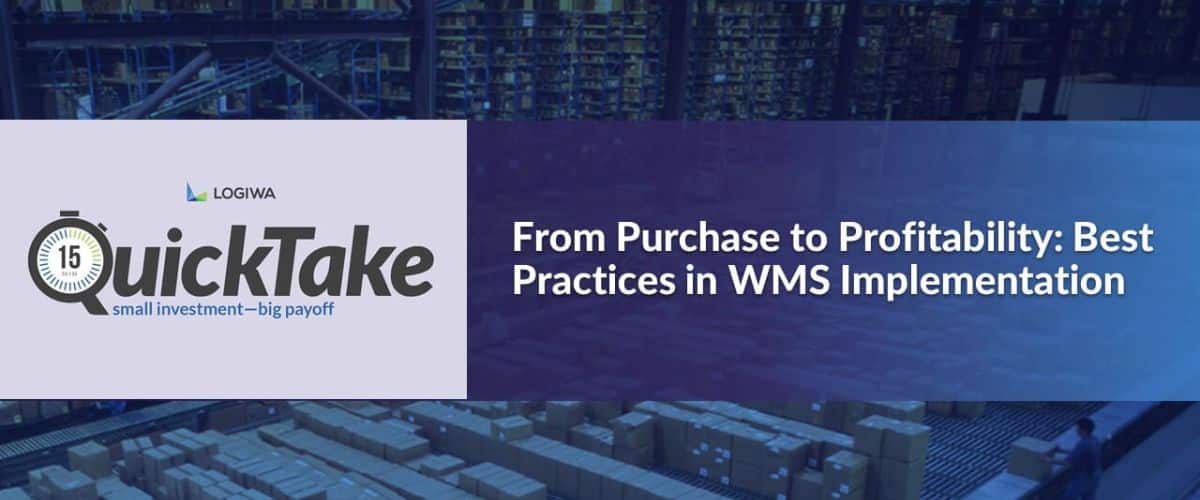Contents
Planning for Your WMS Software Implementation
From the timing of your implementation to finding the right vendor and solution to meet your organization’s needs, software implementation will fail without a proper plan. As a rule of thumb, dedicate at least three months to your software implementation: one month to find the right vendor and two months to implement the software in your business.
Some things to consider when planning for your WMS software implementation:
Commit to finding the best solution
Starting the process with a Request for Information (RFI) will help you find the best solution to meet your business needs. Go beyond company websites and brochures for information. Ask questions to determine if the product has the functionality you need.
Separate your wants from your needs and determine which functions are most critical to your decision-making process. Suppose you need to be able to scan sku barcodes and print labels to operate effectively. In that case, those features are likely more important than having a cool-looking interface.
Get your employees excited
Getting your employees onboard is crucial in the early stages of software implementation. In the pre-implementation stage, you can address any resistance employees may have about using new software, and demonstrate how implementing new solutions will improve operations and their workload.
Make your employees part of the decision-making process to help them feel more invested. Ask them what tools and functionality they need to help them do their jobs more efficiently and effectively.
Prepare resources
Determine the resources you’ll need to execute the software implementation. Hire a project manager or implementation manager dedicated to the project, set up the appropriate racking for business-to-consumer operations, or purchase equipment such as scanners, printers, or mobile computers.
Clean up your data
Switching to new software can be an excellent opportunity to clean out your data and start fresh with your new software. It’s the perfect time to clear out discontinued SKUs, former customers or vendors, or rack locations that no longer exist in your warehouse. It’s also a great time to conduct a complete inventory count.
Make sure you can export the data from your existing system and find out from your vendor what is required to import your clean data into the new system.
Analyze and list all of your integration requirements
Before implementation, you’ll need to prepare API keys for carrier and online store integrations and create mapping documents for EDI integrations. An integration flow chart is a helpful tool for this step.

Optimizing Your Onboarding Journey
Successful software implementation can’t be done off the side of someone’s desk. Assign a dedicated project manager (PM) to lead your implementation from start to finish. A PM will ensure you meet timelines, your organization’s needs are met, and strong lines of communication between your business and the software vendor are established and maintained.
Other team members should include your IT team and super-users; these groups will need to be managed by your PM. A backup project manager is also good if your primary PM becomes unavailable.
Super-users will be responsible for learning the product, testing processes, and ensuring the software meets your unique operational needs. This group will also act as in-house trainers after launch. Super-user assignments can also be broken down by processes: you could have a super-user for inbound processes and a different one for outbound processes.
Set Clear Goals
Your PM must establish what “going live” means to your organization. Do you need the system to be up and running, or do you want to go through a more extensive implementation process that addresses future use cases? Setting clear goals will help you focus on building a system that addresses the functions that you need.
Break it down
When thinking about how you’ll accomplish your implementation goals, break your processes and actions into specific detail.
-
- Set clear action items and be specific about where the responsibility lies for completing those action items.
- Be specific about the tasks you need to accomplish in your workflow. Don’t just create an action item called “picking location set up.” Break it down into the specific steps creating a list of locations, establishing pick paths, and setting up packing stations.
Track your progress
Keep your stakeholders informed and track your progress using a tool to keep track of action items and next steps. You can use something as simple as a Google Sheet or a more sophisticated project management tool.
Provide ample training
If employees don’t know how to use your software, you’re flushing time and money down the drain.
It’s important to schedule training for your whole team, including hands-on training, to help your employees retain the information. Additionally, research shows that people are more likely to ask questions during hands-on training sessions, which will help them better understand the system.
Staying Engaged After Onboarding (post-implementation)
Effective software implementation requires ongoing management even after the system is up and running. New employees need training, new features must be implemented, and issues and bugs must be addressed quickly.
Some things to keep in mind post-implementation:
-
- Create support documentation and platforms: how-to documents and videos, process guides, and flow charts are helpful tools to keep employees up to date. Don’t be afraid to make your own document library to meet your specific needs, and take advantage of documentation provided by the vendor.
- Keep in touch with your customer success manager (CSM): your CSM will keep you informed of new features and functions. Regular check-ins will allow you to address issues or propose new ideas.
- Use vendor support teams efficiently and effectively: when submitting a support ticket, provide as much information as possible, including screenshots or the steps you took that resulted in the issue. Collecting this data will also help identify training gaps and allow you to solve them as soon as possible.
- Create internal support structures: if you manage multiple warehouses, you’ll need to prioritize issues by importance. Centralize your communications with your vendor to help streamline your support services and have a better experience overall.
Three Quick Takeaways About Software Implementation
- Plan ahead and know what you’re looking for.
- Set clear goals, break down the action items, track progress, and conduct ample training and practice.
- Utilize support structure for continuous improvement after your go-live (e.g., customer success manager, support teams, documents and platforms, etc.)
Implementing new software in your business is a big undertaking that can affect your operations on many levels, from profits to customer satisfaction to employee retention. Proper planning before, during, and after implementation will ensure your organization’s success. The best software is useless if implemented incorrectly, and you and your vendor partner need to work together as one team.
To learn how Logiwa can support your business through every step of your WMS software implementation process, reach out to our sales team or request a free demo.





